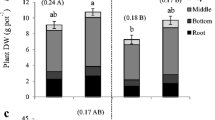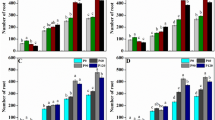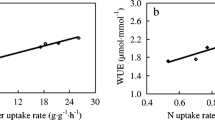Abstract
Purpose
Phosphorus (P) is one of the plant nutrients most frequently deficient in soils. Under such condition, adoption of P-efficient crops is desirable to maintain agricultural production and avoid heavy reliance on fertilizer application. Previous studies reported significant genotypic difference in internal P use efficiency (PUE) in rice, but key physiological processes remain poorly understood. We aimed at revealing novel key factors that affect PUE.
Methods
Rice seedlings were cultivated with different nitrogen (N) sources, and PUE and root traits were characterized. In addition, genotypes that differ in P efficiency were grown under different P supply and growth, gene expression and nutrient uptake were analyzed.
Results
Addition of nitrate to P-deficient plants improved PUE compared with ammonium-only plants. Maximum root length of P-inefficient plants was significantly shorter in the presence of ammonium compared with nitrate-only plants under low P supply, while the difference was absent in P-efficient plants. Under low P supply, P-efficient genotypes had lower ratio of ammonium/nitrate accumulation in root and AMT1;1/NRT1.1B expression (encoding an ammonium and nitrate transporter, respectively) than P-inefficient plants, suggesting that PUE positively correlates with the ability to use nitrate. The ability to use nitrate also positively correlated with root efficiency in the field under low P supply, suggesting that nitrate use may positively modulate both internal P utilization and P uptake.
Conclusion
This study provides physiological evidence that N metabolism is linked with PUE and suggests that strengthening the ability to use nitrate may improve P use, hence contributing to the crop production in P-impoverished soils.






Similar content being viewed by others
Abbreviations
- PAE:
-
P acquisition efficiency
- PUE:
-
Internal P use efficiency
- RE:
-
Root efficiency
References
Adem GD, Ueda Y, Hayes PE, Wissuwa M (2020) Genetic and physiological traits for internal phosphorus utilization efficiency in rice. PLoS ONE 15:e0241842. https://doi.org/10.1371/journal.pone.0241842
Andrianary BH, Tsujimoto Y, Rakotonindrina H et al (2021) Phosphorus application affects lowland rice yields by changing phenological development and cold stress degrees in the central highlands of Madagascar. F Crop Res 271:108256. https://doi.org/10.1016/j.fcr.2021.108256
Barrow NJ (2017) The effects of pH on phosphate uptake from the soil. Plant Soil 410:401–410. https://doi.org/10.1007/s11104-016-3008-9
Briskin DP, Hanson JB (1992) How does the plant plasma membrane H+-ATPase pump protons? J Exp Bot 43:269–289. https://doi.org/10.1093/jxb/43.3.269
Cai J, Chen L, Qu H et al (2012) Alteration of nutrient allocation and transporter genes expression in rice under N, P, K, and Mg deficiencies. Acta Physiol Plant 34:939–946. https://doi.org/10.1007/s11738-011-0890-x
Cooper J, Lombardi R, Boardman D, Carliell-Marquet C (2011) The future distribution and production of global phosphate rock reserves. Resour Conserv Recycl 57:78–86. https://doi.org/10.1016/j.resconrec.2011.09.009
Crawford NM (1995) Nitrate: nutrient and signal for plant growth. Plant Cell 7:859–868. https://doi.org/10.1105/tpc.7.7.859
Crawford NM, Glass ADM (1998) Molecular and physiological aspects of nitrate uptake in plants. Trends Plant Sci 3:389–395. https://doi.org/10.1016/S1360-1385(98)01311-9
De Angeli A, Monachello D, Ephritikhine G et al (2006) The nitrate/proton antiporter AtCLCa mediates nitrate accumulation in plant vacuoles. Nature 442:939–942. https://doi.org/10.1038/nature05013
Erisman JW, Sutton MA, Galloway J et al (2008) How a century of ammonia synthesis changed the world. Nat Geosci 1:636–639. https://doi.org/10.1038/ngeo325
Falkengren-Grerup U (1995) Interspecies differences in the preference of ammonium and nitrate in vascular plants. Oecologia 102:305–311. https://doi.org/10.1007/BF00329797
Ferreira LM, de Souza VM, Tavares OCH et al (2015) OsAMT1.3 expression alters rice ammonium uptake kinetics and root morphology. Plant Biotechnol Rep 9:221–229. https://doi.org/10.1007/s11816-015-0359-2
Fried M, Zsoldos F, Vose PB, Shatokhin IL (1965) Characterizing the nitrate and ammonium uptake process of rice roots by use of 15N labelled NH4NO3. Physiol Plant 18:313–320. https://doi.org/10.1111/j.1399-3054.1965.tb06894.x
Gonzalez D, Postma J, Wissuwa M (2021) Cost-benefit analysis of the upland-rice root architecture in relation to phosphate : 3D simulations highlight the importance of S-type lateral roots for reducing the pay-off time. Front Plant Sci 12:641835. https://doi.org/10.3389/fpls.2021.641835
Hachiya T, Sakakibara H (2017) Interactions between nitrate and ammonium in their uptake, allocation, assimilation, and signaling in plants. J Exp Bot 68:2501–2512. https://doi.org/10.1093/jxb/erw449
Hartmann J, Asch F (2018) Micro-method to determine iron concentrations in plant tissues using 2,2′ bipyridine. J Plant Nutr Soil Sci 181:357–363. https://doi.org/10.1002/jpln.201700433
Hayes PE, Adem GD, Pariasca-Tanaka J, Wissuwa M (2021) Leaf phosphorus fractionation in rice to understand internal phosphorus-use efficiency. Ann Bot 129:287–302. https://doi.org/10.1093/aob/mcab138
Heuer S, Gaxiola R, Schilling R et al (2017) Improving phosphorus use efficiency: a complex trait with emerging opportunities. Plant J 90:868–885. https://doi.org/10.1111/tpj.13423
Hirano T, Satoh Y, Ohki A et al (2008) Inhibition of ammonium assimilation restores elongation of seminal rice roots repressed by high levels of exogenous ammonium. Physiol Plant 134:183–190. https://doi.org/10.1111/j.1399-3054.2008.01117.x
Hu B, Jiang Z, Wang W et al (2019) Nitrate–NRT1.1B–SPX4 cascade integrates nitrogen and phosphorus signalling networks in plants. Nat Plants 5:401–413. https://doi.org/10.1038/s41477-019-0384-1
Kawata S, Maruyama S, Soejima M (1977) Root formation in rice plant and levels of nitrogen supply. Japanese J Crop Sci 46:193–198. https://doi.org/10.1626/jcs.46.193
Kiba T, Inaba J, Kudo T et al (2018) Repression of nitrogen starvation responses by members of the arabidopsis GARP-type transcription factor NIGT1/HRS1 subfamily. Plant Cell 30:925–945. https://doi.org/10.1105/tpc.17.00810
Konishi N, Ma JF (2021) Three polarly localized ammonium transporter 1 members are cooperatively responsible for ammonium uptake in rice under low ammonium condition. New Phytol 232:1778–1792. https://doi.org/10.1111/nph.17679
Kuppe CW, Kirk GJD, Wissuwa M, Postma JA (2022) Rice increases phosphorus uptake in strongly sorbing soils by intra-root facilitation. Plant Cell Environ 45:884–899. https://doi.org/10.1111/pce.14285
Li Q, Li BH, Kronzucker HJ, Shi WM (2010) Root growth inhibition by NH4+ in Arabidopsis is mediated by the root tip and is linked to NH4+ efflux and GMPase activity. Plant Cell Environ 33:1529–1542. https://doi.org/10.1111/j.1365-3040.2010.02162.x
Liu F, Wang Z, Ren H et al (2010) OsSPX1 suppresses the function of OsPHR2 in the regulation of expression of OsPT2 and phosphate homeostasis in shoots of rice. Plant J 62:508–517. https://doi.org/10.1111/j.1365-313X.2010.04170.x
López-Arredondo DL, Leyva-González MA, González-Morales SI et al (2014) Phosphate nutrition: Improving low-phosphate tolerance in crops. Annu Rev Plant Biol 65:95–123. https://doi.org/10.1146/annurev-arplant-050213-035949
Lynch JP (2011) Root phenes for enhanced soil exploration and phosphorus acquisition: Tools for future crops. Plant Physiol 156:1041–1049. https://doi.org/10.1104/pp.111.175414
MacDonald GK, Bennett EM, Potter PA, Ramankutty N (2011) Agronomic phosphorus imbalances across the world’s croplands. Proc Natl Acad Sci U S A 108:3086–3091. https://doi.org/10.1073/pnas.1010808108
Maeda Y, Konishi M, Kiba T et al (2018) A NIGT1-centred transcriptional cascade regulates nitrate signalling and incorporates phosphorus starvation signals in Arabidopsis. Nat Commun 9:1376. https://doi.org/10.1038/s41467-018-03832-6
Marschner H (1995) Mineral nutrition of higher plants, 2nd edn. Elsevier Ltd
Martinoia E, Heck U, Wiemken A (1981) Vacuoles as storage compartments for nitrate in barley leaves. Nature 289:292–294. https://doi.org/10.1038/289292a0
Medici A, Szponarski W, Dangeville P et al (2019) Identification of molecular integrators shows that nitrogen actively controls the phosphate starvation response in plants. Plant Cell 31:1171–1184. https://doi.org/10.1105/tpc.18.00656
Meier M, Liu Y, Lay KS et al (2020) Auxin-mediated root branching is determined by the form of available nitrogen. Nat Plants 6:1136–1145. https://doi.org/10.1038/s41477-020-00756-2
Meng Q, Zhang W, Hu X et al (2020) Two ADP-glucose pyrophosphorylase subunits, OsAGPL1 and OsAGPS1, modulate phosphorus homeostasis in rice. Plant J 104:1269–1284. https://doi.org/10.1111/tpj.14998
Mori A, Fukuda T, Vejchasarn P et al (2016) The role of root size versus root efficiency in phosphorus acquisition in rice. J Exp Bot 67:1179–1189. https://doi.org/10.1093/jxb/erv557
Murphy J, Riley JP (1962) A modified single solution method for the determination of phosphate in natural waters. Anal Chim Acta 27:31–36. https://doi.org/10.1016/S0003-2670(00)88444-5
Niang A, Becker M, Ewert F et al (2017) Variability and determinants of yields in rice production systems of West Africa. F Crop Res 207:1–12. https://doi.org/10.1016/j.fcr.2017.02.014
Nishigaki T, Tsujimoto Y, Rinasoa S et al (2019) Phosphorus uptake of rice plants is affected by phosphorus forms and physicochemical properties of tropical weathered soils. Plant Soil 435:27–38. https://doi.org/10.1007/s11104-018-3869-1
Nishigaki T, Tsujimoto Y, Rakotoson T et al (2021) Soil phosphorus retention can predict responses of phosphorus uptake and yield of rice plants to P fertilizer application in flooded weathered soils in the central highlands of Madagascar. Geoderma 402:115326. https://doi.org/10.1016/j.geoderma.2021.115326
Patterson K, Cakmak T, Cooper A et al (2010) Distinct signalling pathways and transcriptome response signatures differentiate ammonium- and nitrate-supplied plants. Plant Cell Environ 33:1486–1501. https://doi.org/10.1111/j.1365-3040.2010.02158.x
Ponnamperuma FN (1972) The chemistry of submerged soils. Adv Agron 24:29–96. https://doi.org/10.1016/S0065-2113(08)60633-1
Price G (2006) Australian Soil Fertility Manual, 3rd edn. Fertilizer Industry Federation of Australia and CSIRO Publishing, Melbourne
Prodhan MA, Pariasca-Tanaka J, Ueda Y et al (2022) Comparative transcriptome analysis reveals a rapid response to phosphorus deficiency in a phosphorus-efficient rice genotype. Sci Rep 12:9460. https://doi.org/10.1038/s41598-022-13709-w
Rakotoson T, Tsujimoto Y, Nishigaki T (2022) Phosphorus management strategies to increase lowland rice yields in Sub-Saharan Africa. F Crop Res 275:108370. https://doi.org/10.1016/j.fcr.2021.108370
Rao EVSP, Prasad R, Abrol YP (1979) Nitrate assimilation in rice grown under lowland conditions. Physiol Plant 47:139–143. https://doi.org/10.1111/j.1399-3054.1979.tb03205.x
Rose TJ, Rose MT, Pariasca-Tanaka J et al (2011) The frustration with utilization: why have improvements in internal phosphorus utilization efficiency in crops remained so elusive? Front Plant Sci 2:73. https://doi.org/10.3389/fpls.2011.00073
Rose TJ, Mori A, Julia CC, Wissuwa M (2016) Screening for internal phosphorus utilisation efficiency: comparison of genotypes at equal shoot P content is critical. Plant Soil 401:79–91. https://doi.org/10.1007/s11104-015-2565-7
Rubio-Asensio JS, Bloom AJ (2017) Inorganic nitrogen form: a major player in wheat and Arabidopsis responses to elevated CO2. J Exp Bot 68:2611–2625. https://doi.org/10.1093/jxb/erw465
Saito K, Vandamme E, Johnson JM et al (2019) Yield-limiting macronutrients for rice in sub-Saharan Africa. Geoderma 338:546–554. https://doi.org/10.1016/j.geoderma.2018.11.036
Takahashi T, Dahlgren RA (2016) Nature, properties and function of aluminum-humus complexes in volcanic soils. Geoderma 263:110–121. https://doi.org/10.1016/j.geoderma.2015.08.032
Taylor AR, Bloom AJ (1998) Ammonium, nitrate, and proton fluxes along the maize root. Plant, Cell Environ 21:1255–1263. https://doi.org/10.1046/j.1365-3040.1998.00357.x
Tian WH, Ye JY, Cui MQ et al (2021) A transcription factor STOP1-centered pathway coordinates ammonium and phosphate acquisition in Arabidopsis. Mol Plant 14:1554–1568. https://doi.org/10.1016/j.molp.2021.06.024
Ueda Y, Kiba T, Yanagisawa S (2020a) Nitrate-inducible NIGT1 proteins modulate phosphate uptake and starvation signalling via transcriptional regulation of SPX genes. Plant J 102:448–466. https://doi.org/10.1111/tpj.14637
Ueda Y, Ohtsuki N, Kadota K et al (2020b) Gene regulatory network and its constituent transcription factors that control nitrogen deficiency responses in rice. New Phytol 227:1434–1452. https://doi.org/10.1111/nph.16627
Ueda Y, Sakuraba Y, Yanagisawa S (2021) Environmental control of phosphorus acquisition: a piece of the molecular framework underlying nutritional homeostasis. Plant Cell Physiol 62:573–581. https://doi.org/10.1093/pcp/pcab010
Vandamme E, Ahouanton K, Mwakasege L et al (2018) Phosphorus micro-dosing as an entry point to sustainable intensification of rice systems in sub-Saharan Africa. F Crop Res 222:39–49. https://doi.org/10.1016/j.fcr.2018.02.016
Vinod KK, Heuer S (2012) Approaches towards nitrogen- and phosphorus-efficient rice. AoB Plants 2012:pls028. https://doi.org/10.1093/aobpla/pls028
Wang MY, Siddiqi MY, Ruth TJ, Glass ADM (1993) Ammonium uptake by rice roots. I. Fluxes and subcellular distribution of 13NH4+. Plant Physiol 103:1249–1258. https://doi.org/10.1104/pp.103.4.1249
Wang F, Morrison King JD, Rose T et al (2017) Can natural variation in grain P concentrations be exploited in rice breeding to lower fertilizer requirements? PLoS ONE 12:e0179484. https://doi.org/10.1371/journal.pone.0179484
Wang P, Yamaji N, Inoue K et al (2020a) Plastic transport systems of rice for mineral elements in response to diverse soil environmental changes. New Phytol 226:156–169. https://doi.org/10.1111/nph.16335
Wang S, Chen A, Xie K et al (2020b) Functional analysis of the OsNPF4.5 nitrate transporter reveals a conserved mycorrhizal pathway of nitrogen acquisition in plants. Proc Natl Acad Sci U S A 117:16649–16659. https://doi.org/10.1073/pnas.2000926117
Watanabe M, Walther D, Ueda Y et al (2020) Metabolomic markers and physiological adaptations for high phosphate utilization efficiency in rice. Plant Cell Environ 43:2066–2079. https://doi.org/10.1111/pce.13777
Waters BM, Troupe GC (2012) Natural variation in iron use efficiency and mineral remobilization in cucumber (Cucumis sativus). Plant Soil 352:185–197. https://doi.org/10.1007/s11104-011-0988-3
Wissuwa M, Gamat G, Ismail AM (2005) Is root growth under phosphorus deficiency affected by source or sink limitations? J Exp Bot 56:1943–1950. https://doi.org/10.1093/jxb/eri189
Wissuwa M, Kondo K, Fukuda T et al (2015) Unmasking novel loci for internal phosphorus utilization efficiency in rice germplasm through genome-wide association analysis. PLoS ONE 10:e0124215. https://doi.org/10.1371/journal.pone.0124215
Wissuwa M, Gonzalez D, Watts-Williams SJ (2020) The contribution of plant traits and soil microbes to phosphorus uptake from low-phosphorus soil in upland rice varieties. Plant Soil 448:523–537. https://doi.org/10.1007/s11104-020-04453-z
Xu G, Fan X, Miller AJ (2012) Plant nitrogen assimilation and use efficiency. Annu Rev Plant Biol 63:153–182. https://doi.org/10.1146/annurev-arplant-042811-105532
Yoshida S, Forno DA, Cock JH, Gomez KA (1976) Laboratory manual for physiological studies of rice, Third edit. The International Rice Research Institute, Manila
Zeng H, Liu G, Kinoshita T et al (2012) Stimulation of phosphorus uptake by ammonium nutrition involves plasma membrane H+ATPase in rice roots. Plant Soil 357:205–214. https://doi.org/10.1007/s11104-012-1136-4
Zhang M, Wang Y, Chen X et al (2021) Plasma membrane H+-ATPase overexpression increases rice yield via simultaneous enhancement of nutrient uptake and photosynthesis. Nat Commun 12:735. https://doi.org/10.1038/s41467-021-20964-4
Zhang Z-S, Xia J-Q, Alfatih A et al (2022) Rice NIN-LIKE PROTEIN 3 modulates nitrogen use efficiency and grain yield under nitrate-sufficient conditions. Plant Cell Environ 45:1526–1536. https://doi.org/10.1111/pce.14294
Zhao H, Yao W, Ouyang Y et al (2015) RiceVarMap: A comprehensive database of rice genomic variations. Nucleic Acids Res 43:D1018–D1022. https://doi.org/10.1093/nar/gku894
Acknowledgements
The authors thank Dr. K. Ikazaki and N. Sekine for the technical support in the mass spectrometry analyses. The authors thank M. Yonemoto and M. Matsuyama for the assistance in element analyses.
Funding
This study was funded by JIRCAS research program “Resilient crops”.
Author information
Authors and Affiliations
Contributions
Conceptualization, investigation, formal analysis, visualization, writing-original manuscript: YU
Resources, supervision, methodology, writing-review & editing: MW
Corresponding author
Ethics declarations
Competing interests
The authors have no competing interests to declare that are relevant to the content of this article.
Additional information
Responsible Editor: Ad C. Borstlap.
Publisher’s note
Springer Nature remains neutral with regard to jurisdictional claims in published maps and institutional affiliations.
Supplementary Information
Below is the link to the electronic supplementary material.
Rights and permissions
Springer Nature or its licensor holds exclusive rights to this article under a publishing agreement with the author(s) or other rightsholder(s); author self-archiving of the accepted manuscript version of this article is solely governed by the terms of such publishing agreement and applicable law.
About this article
Cite this article
Ueda, Y., Wissuwa, M. Physiological evidence that nitrate use positively correlates with internal phosphorus utilization efficiency and phosphorus uptake efficiency in rice (Oryza sativa L.). Plant Soil 481, 547–561 (2022). https://doi.org/10.1007/s11104-022-05655-3
Received:
Accepted:
Published:
Issue Date:
DOI: https://doi.org/10.1007/s11104-022-05655-3




